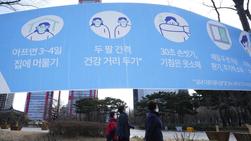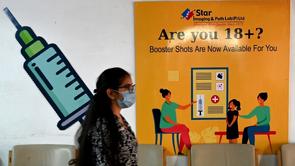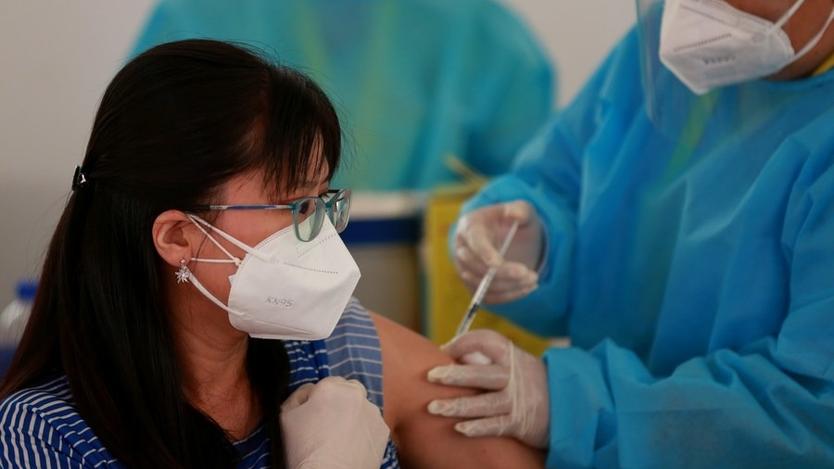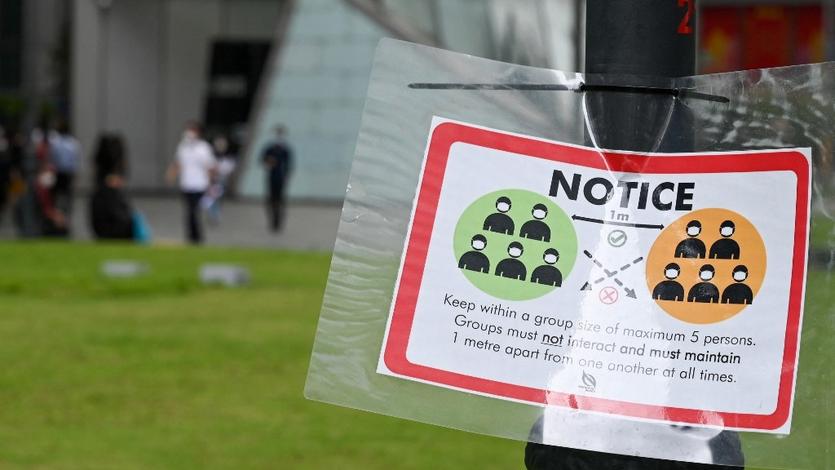 People wearing face masks pass by a banner reminding precautions against the coronavirus at a park in Seoul, South Korea on Jan 24, 2022. (AHN YOUNG-JOON / AP)
People wearing face masks pass by a banner reminding precautions against the coronavirus at a park in Seoul, South Korea on Jan 24, 2022. (AHN YOUNG-JOON / AP)
NEW DELHI / ISLAMABAD / YANGON / SINGAPORE / HANOI / VIENTIANE / KUALA LUMPUR / WELLINGTON - South Korea logged its second-highest monthly deaths in April due to the effect of the COVID-19 pandemic, statistical office data showed on Wednesday.
The number of deaths was 36,697 in April, up 46.3 percent from the same month of last year, according to Statistics Korea.
It marked the highest April figure and also the second-highest after hitting a record high of 44,487 in March.
The record deaths were attributed to the COVID-19 pandemic, driven by the Omicron variant spread in the months.
The country reported 8,992 new COVID-19 cases as of midnight Tuesday compared to 24 hours ago, raising the total number of infections to 18,298,341, the health authorities said.
The daily caseload was down from 9,310 in the previous day and lower than 9,428 tallied a week earlier, according to the Korea Disease Control and Prevention Agency (KDCA).
For the past week, the daily average number of confirmed cases was 7,131.
 A girl walks past a poster at a vaccination centre in New Delhi on April 10, 2022, after government announced the paid precaution dose against the coronavirus to be available for everyone above 18 years of age at private vaccination centers. (MONEY SHARMA / AFP)
A girl walks past a poster at a vaccination centre in New Delhi on April 10, 2022, after government announced the paid precaution dose against the coronavirus to be available for everyone above 18 years of age at private vaccination centers. (MONEY SHARMA / AFP)
India
India has been witnessing a surge in the number of new COVID-19 cases over the past couple of weeks, as daily new cases have risen from nearly 2,000 a month ago to over 13,000.
The number of deaths per day due to the pandemic also surged to 20.
On June 1, the country's active caseload stood at 18,386, which increased to 79,313 on Tuesday morning with a steep rise of nearly 61,000 cases, or 331 percent.
The past 21 days also saw a steep rise of around 160,000 cases in the total tally, with the figure rising up from 43,160,832 to 43,319,396.
On Wednesday, India reported 12,249 new COVID-19 cases, taking the total tally to 43,331,645, according to the data released by the federal health ministry.
The current situation has once again caught the attention of government authorities and the general public at large, as concerns have been raised from different quarters of society.
Health authorities have ruled out an outbreak of a fourth COVID-19 wave under the present circumstances.
Amid the rise in the number of fresh cases in the country, emphasis has been placed on wearing face masks and observing the COVID Appropriate Behavior (CAB) once again. A couple of states have issued fresh advisories directing people to strictly observe the CAB.
The Jharkhand state government on Monday issued new guidelines, making it mandatory for everyone to wear face masks in public places.
Delhi, which has been one of the most COVID-affected places in the country, has made it mandatory to wear face masks in public places. A fine of 500 Indian rupees ($6.4) on not wearing a face mask is also in force in the national capital.
The capital too has been witnessing a rise in the number of COVID-19 cases. According to official figures released Monday evening, 1,060 new COVID-19 infections were reported during the previous 24 hours. The number of active cases stood at 5,375, while the positivity rate rose to 10.09 percent.
Medical and health experts have stated complacency as one of the biggest reasons for the sudden spurt in the number of new cases, particularly people moving around publicly without wearing face masks.
Vice-Chairman of Delhi's Sir Ganga Ram Hospital Dr. S.P. Byotra told Xinhua that COVID-19 cases were once again rising in the country because people were not following CAB while moving out in public places.
"There are different causes behind the surge, like not wearing face masks, attending parties in large groups, going to market places without face masks, the lack of habit of following social distancing," he said.
As per the latest available data, over 1.96 billion COVID-19 vaccine doses have been administered in India so far. The vaccination program, which began one-and-a-half years ago, is still going on.
Laos
A second consignment of 500,000 doses of the Sinopharm COVID-19 vaccine donated by the Malaysian government has arrived in Lao capital Vientiane, local daily Vientiane Times reported Wednesday.
Malaysia's first donation of 283,400 doses of the AstraZeneca COVID-19 vaccine arrived in Laos last December. The donations are part of Malaysia's contribution to global efforts to end the pandemic and support Laos' goal to vaccinate at least 80 percent of the adult population by the end of this year, the Lao daily report said.
The latest batch of donated vaccine will be administered to people of all age groups and those with underlying health conditions, under the National Deployment and Vaccination Plan, said the report.
Malaysia
Malaysia reported 1,921 new COVID-19 infections as of midnight Tuesday, bringing the national total to 4,544,626, according to the health ministry.
There are 114 new imported cases, with 1,807 cases being local transmissions, data released on the ministry's website showed.
Two more deaths have been reported, bringing the death toll to 35,737.
 A woman receives a shot of China's Sinopharm COVID-19 vaccine in Yangon, Myanmar, Aug 29, 2021. (PHOTO / XINHUA)
A woman receives a shot of China's Sinopharm COVID-19 vaccine in Yangon, Myanmar, Aug 29, 2021. (PHOTO / XINHUA)
Myanmar
Myanmar on Tuesday confirmed 14 new cases of COVID-19 in the past 24 hours, bringing the tally to 613,508, according to the country's Health Ministry.
The health authorities tested 5,033 people for COVID-19 in the past 24 hours, and the daily positivity rate was 0.28 percent.
It added that the death toll from COVID-19 in the country remained unchanged at 19,434 as no new deaths were confirmed in the past 24 hours.
New Zealand
New Zealand recorded 5,499 new community cases of COVID-19 with 18 more deaths, the Ministry of Health said on Wednesday.
Among the new community infections, 1,637 were reported in the largest city Auckland, the ministry said.
In addition, 78 new cases of COVID-19 were detected at the New Zealand border.
Currently, 334 COVID-19 patients are being treated in hospitals, including four in intensive care units or high dependency units.
 A health worker inoculates a student with a dose of the Pfizer vaccine against the coronavirus at his school in Karachi on Jan 24, 2022. (ASIF HASSAN / AFP)
A health worker inoculates a student with a dose of the Pfizer vaccine against the coronavirus at his school in Karachi on Jan 24, 2022. (ASIF HASSAN / AFP)
Pakistan
Another wave of COVID-19 is feared in Pakistan as the positivity rate in the two cities of Karachi and Hyderabad in the country's southern Sindh province surpassed 10 percent, local media reported on Tuesday.
According to the state's official website for COVID-19 data, 113 people tested positive for COVID-19 from across the country on Monday with a positivity rate of almost 1.5 percent.
The positivity rate in the southern port city of Karachi, which is also the country's largest city in terms of area and population, was 10.08 percent and in Hyderabad, it was 16.6 percent, local media said.
One patient lost his life on Monday while 58 COVID-19 patients are currently in a critical condition, the official data said.
In Pakistan's capital Islamabad, the positivity rate exceeded over 2 percent, it added.
 A notice warning people not to gather in groups larger than five persons as part of restrictions to hald the spread of the coronavirus is displayed at Raffles Place financial business district in Singapore on Jan 4, 2022. (ROSLAN RAHMAN / AFP)
A notice warning people not to gather in groups larger than five persons as part of restrictions to hald the spread of the coronavirus is displayed at Raffles Place financial business district in Singapore on Jan 4, 2022. (ROSLAN RAHMAN / AFP)
Singapore
Singapore reported 7,109 new cases of COVID-19 on Tuesday, bringing the total tally to 1,378,090.
Of the new cases, 502 were detected through polymerase chain reaction (PCR) tests and 6,607 through antigen rapid test (ART) tests, according to statistics released by the Ministry of Health.
No death was reported from COVID-19 on Tuesday, keeping the total death toll at 1,405, according to the ministry.
The ministry also said on Tuesday that Singapore has witnessed a 23 percent week-on-week increase in COVID-19 community infections, and the rise is largely driven by the increased spread of newer Omicron subvariants BA.4 and BA.5.
About 30 percent of the COVID-19 cases in the community in the past week were cases with BA.4 and BA.5 subvariants, as compared to 17 percent and 3 percent for the previous two weeks, respectively.
"The surge in BA.4 and BA.5 cases is likely to continue, driven by their higher transmissibility compared to BA.2," said the ministry.
Vietnam
Vietnam recorded 748 new COVID-19 cases on Tuesday, up by 227 from Monday, according to its Ministry of Health.
All the new infections were domestically transmitted in 40 provinces and cities.
The Vietnamese capital Hanoi remained the pandemic hotspot with 145 new cases recorded on Tuesday, followed by northern Phu Tho province with 74 and the central Nghe An province with 44.
The infections brought the total tally to 10,738,909 with 43,084 deaths.


